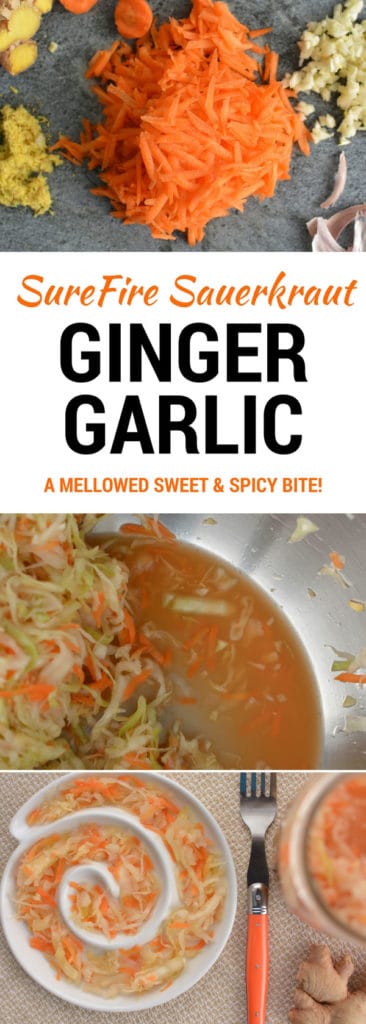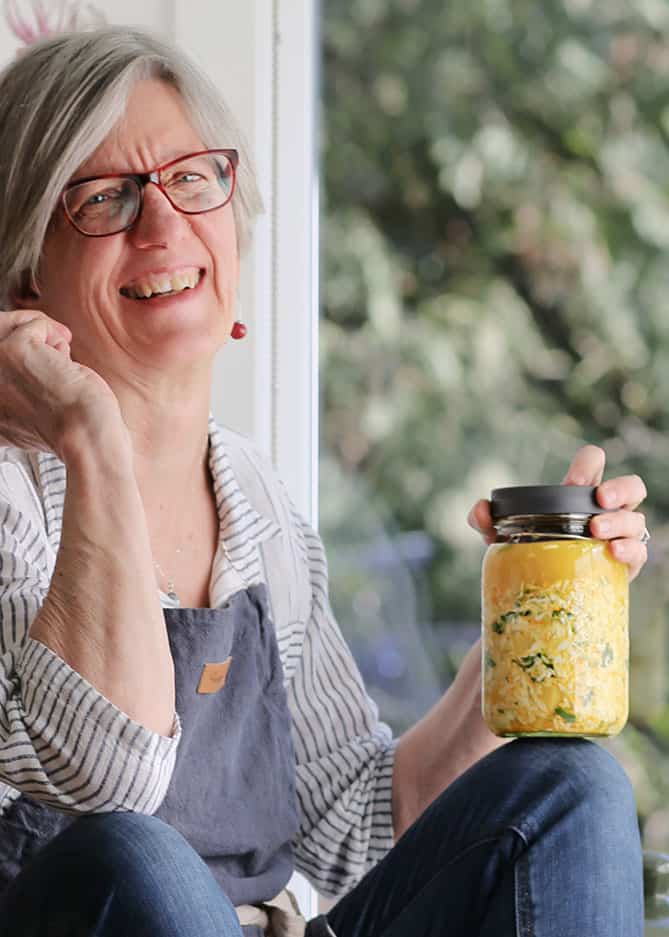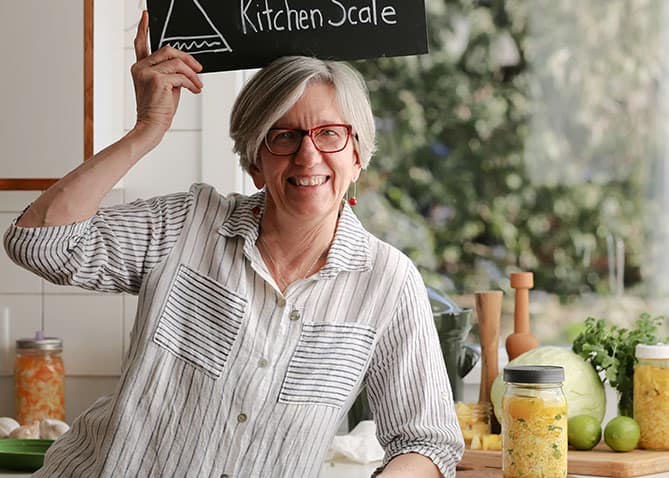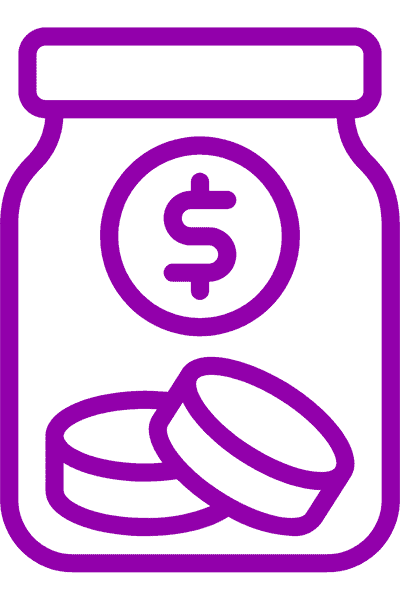My family can never get enough of Ginger Carrot Sauerkraut, so I tend to make a big batch of it every fall in my 3-gallon Ohio Stoneware crock. It is full of sweet carrots and has a touch of spicy ginger to add a nice depth of flavor and help with digestion – along with all those magical microbes living in the sauerkraut.
Enjoy this sauerkraut recipe and experiment around with just how much ginger you like.
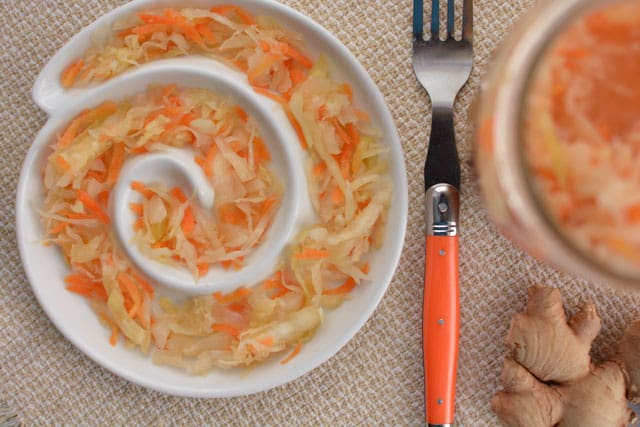
This post was originally published on September 26, 2014. It was last updated with new information and images on March 1, 2017.
Note: If this is your first time to make sauerkraut, learn how to choose the best cabbage for sauerkraut, and use The SureFire Sauerkraut Method… In a Jar: 7 Easy Steps, with its step-by-step photography, tips, and additional fermentation information first, then return to this recipe.

And, once you are comfortable making sauerkraut in a jar and want to make larger batches follow: The SureFire Sauerkraut Method… In a Crock: 7 Easy Steps.

Notes and Tips to Get You Started on this Ginger Carrot Sauerkraut Recipe
Two Easy Ways to Peel Ginger
I keep both fresh and frozen ginger on hand. For frozen ginger, grate it using the fine side of your grater. The peel is left on the outside of the grater box and the minced ginger sits in a nice pile on your cutting board ready to be scraped into your sauerkraut mixing bowl.
I used to peel fresh ginger with my vegetable peeler and often bemoaned at how much of the ginger I was loosing. Try instead the Spoon Trick as shown in the video below.
Want to Remove the Garlic Smell from Your Hands?
Many swear by the stainless steel trick. Rub soapy hands on the faucet (and then dry it with a towel). Clean hands, shiny faucet. Me? I just wash my hands immediately with soap and water and they’re fine.
Don’t Go Overboard on the Carrots
If you add too many carrots, the sugar content of your ferment is such that you turn it into a sweet or yeasty slime. Like with the garlic, start with 2-3 carrots and gradually increase in subsequent batches until you achieve the balance you want.
Since carrots come in all sizes, it may be easier to add them by weight. A good rule of thumb to follow for any batch of sauerkraut: 75% cabbage, 25% other ingredients. That would mean no more than 7 ounces (200 grams) of carrots.
My Favorite Way to Eat Ginger Carrot Sauerkraut
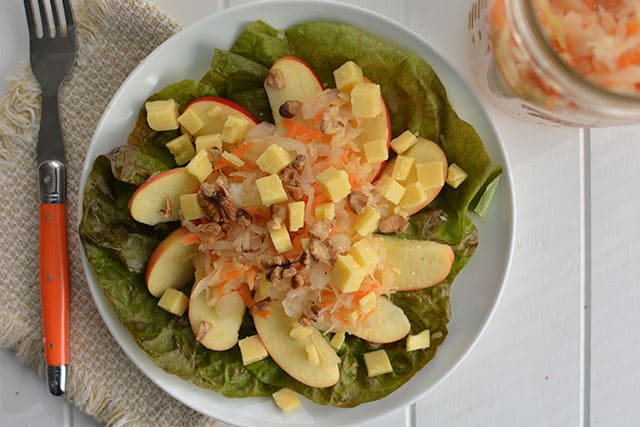
I often use Ginger Carrot Sauerkraut to make a quick and delicious salad. In your bowl, place:
- Diced apple (Or sliced for a more decorative look but, I think the cubes blend better with the rest of the ingredients.)
- Cubed cheddar cheese, mixed with
- Carrot Ginger Sauerkraut tossed, then sprinkled with
- Lightly toasted (if you have time) and crumbled walnuts. A pinch of salt. Refreshing!
- Even more refreshing? Drizzle with a 50/50 lemon juice and honey dressing.
Sure to please even the pickiest of eaters.
For more ideas, check out my ever-growing list of ways to enjoy your sauerkraut.
Ginger Carrot Sauerkraut Recipe
I have two forms of my Ginger Carrot Sauerkraut Recipe for you. The online one that follows – with numerous pictures – and a PDF version below for printing that includes Gourmet Pairing Options and information on recipe ingredients.
The Five Tools I Grab Every Time I Make a Batch of Sauerkraut
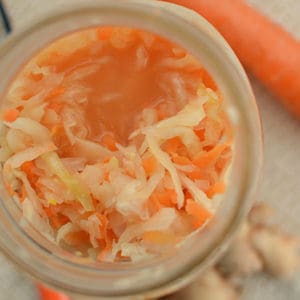
Ginger Carrot Sauerkraut
EQUIPMENT
- Kitchen scale, ideally digital or use given volume measurements
- Cutting board and chef’s knife
- Large mixing bowl
- Vegetable peeler, grater and measuring spoons
- 1-quart (L) wide-mouth canning jar or similar sized jar
- 4-ounce (125 ml) canning jar (jelly jar)
- Wide-mouth plastic storage cap or, just use the lid and rim that comes with jar
INGREDIENTS
- 1 medium head fresh green cabbage, 2 ½–3 pounds (1 kg)
- 2-3 carrots
- 1-2 inch knob of fresh ginger root
- 2-3 garlic cloves
- 1 tablespoon (15 ml) iodine-free salt (fine-grain)
INSTRUCTIONS
- SET UP. Gather Supplies and Set Up ScaleUsing the right amount of salt makes for consistent, repeatable batches and establishes an environment for fermentation to unfold properly.You don’t want to include the weight of your bowl in your measurements, so either zero out the scale (usually done with a button on a digital scale or a knob under the tray on a mechanical scale) or write down the weight of your bowl (tare).

- CHOP. Prep Your Vegetables and CabbageWhen making sauerkraut, you first prepare the flavoring ingredients – carrots, ginger, garlic – then add sliced cabbage. This allows you to add only as much sliced cabbage as necessary to hit 1¾ pounds (28 ounces, 800 grams) on your scale.This is the amount that fits perfectly into a one-quart (liter) jar. Peel and grate carrots, grate or finely mince ginger, finely mince garlic and place in your bowl. Discard the limp outer leaves of the cabbage, setting aside one of the cleaner ones for use during the SUBMERGE step.Quarter, then slice cabbage crosswise into thin ribbons. I leave the core in because I find it helps to hold the layers of cabbage together making the slicing job easier.Add sliced cabbage to your bowl until weight of vegetables and cabbage is 1¾ pounds (28 ounces, 800 grams).

- SALT. Create Your BrineSalt is the workhorse in your ferment. It pulls water out of the cabbage to create an environment where the good bacteria can grow and proliferate and the bad bacteria die off. Just what we want!Sprinkle vegetables and cabbage with 1 tablespoon of salt and mix well. To create the brine without a lot of work, let the bowl of salted cabbage rest for 20 minutes to an hour. Then, massage the vegetables with strong hands until moist, creating the brine. You should be able to tilt the bowl to the side and see a good-sized puddle of brine, about 2–3 inches in diameter. This process can take anywhere from 2 to 5 minutes.

- PACK. Pack Mixture into JarNow that you have a puddle of brine, it’s time to pack the cabbage mixture into your jar.Grab handfuls of the salty, juicy cabbage mixture and pack them into your quart-sized wide-mouth canning jar, periodically pressing the mixture down tightly with your fist or a large spoon so that the brine rises above the top of the mixture and no air pockets remain.Be sure to leave at least 1 inch of space between the top of the cabbage and the top of the jar. Because we weighed out just the right amount of cabbage to fit in your jar, this should happen automatically.Pour any brine left in your mixing bowl into the jar and scrape out any loose bits stuck to the sides of the bowl or to the side of your jar.
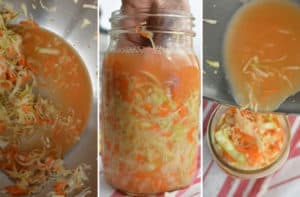
- SUBMERGE. Hold Ferment Below BrineNow make sure your fermenting mixture is in a safe anaerobic (no air) environment. This means that you need to keep the cabbage mixture submerged in the brine while it ferments. Insert your Floaties Trap. Take that cabbage leaf you saved during the SETUP step, tear it down to just fit in the jar, and place it over the surface of the packed cabbage. Forgot to save a cabbage leaf? No problem. You can fold a narrow piece of parchment paper to size or even cut an old plastic lid to size. Place the 4-ounce jelly jar – or other item you're using as a weight – on top of the cabbage leaf, right side up with its lid removed. Lightly (to allow for escape of CO2 gases), screw on the white plastic storage lid.I like to label my jars using green or blue painter’s tape and a permanent marker. I note the flavor of sauerkraut I made and the date I started fermenting.
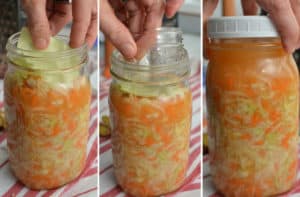
- FERMENT. Ferment for 1 to 4 WeeksTime now for the Mighty Microbes to work for you while you watch and wait. Can you wait 7 days to sample the tangy crunch? The jar on the left is on Day 1; the right, Day 14. Notice how the colors have softened and the brine level has dropped. Place your jar of fermenting sauerkraut in a shallow bowl (to catch the brine that may leak out during the first week of fermentation), out of direct sunlight. Wait for 1 week before opening to sample.For what to expect as your sauerkraut ferments, see SALTY Cabbage to SOUR Sauerkraut: Fermentation Signs to MonitorShould the brine level fall (very unlikely) and remain below the level of the sauerkraut during this first week,dilute 1 Tbsp of salt in 2 cups of water and pour some of this brine over the sauerkraut (removing the little jar first) until it just covers the mixture. Put the little jar back in, screw the lid on lightly and let the fermentation continue.Don’t worry if the brine disappears after the 7- to 10-day mark. By this time, you’ve created a safe environment in which the bacteria that would cause mold or slime has been chased away by the beneficial bacteria produced during the fermentation process.You can ferment your sauerkraut for up to 4 weeks. The longer you ferment it, the greater the number and variety of beneficial bacteria that can be produced.
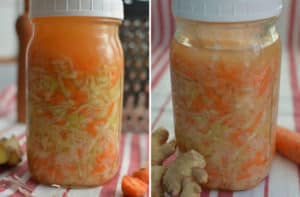
- STORE. Store in Refrigerator for Up to 1 YearAfter fermenting your sauerkraut, it’s ready to go into the refrigerator and ready to be tossed into a salad, spread on a hot dog and eaten straight from the jar!Rinse off the outside of the jar. You can take the little jar out. Clean the rim if necessary (sometimes it can get sticky from the brine that overflows), and screw the lid back on tightly.Add to your label how long you fermented the contents.Enjoy a forkful or two of your sauerkraut with your meals. It will continue to ferment – aging like a fine wine – but at a much slower rate that before. If the flavors are too intense, leave it the jar for a month or two and then eat it. You will be amazed at how the flavors have changed.If successfully fermented (tastes and smells good), your sauerkraut can be kept preserved in your refrigerator for up to a year.
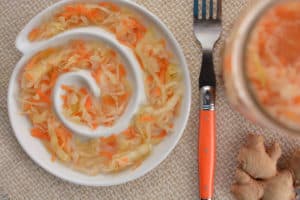
Notes and Tips
- For frozen ginger, grate it using the fine side of your grater. The peel is left on the outside of the grater box and the minced ginger sits in a nice pile on your cutting board ready to be scraped into your sauerkraut mixing bowl.
- For fresh ginger, using a vegetable peeler results to wasting some of the flesh. Instead, try using a spoon to scrape the outer layer.
- Don’t go overboard with the carrots. If you add too many carrots, the sugar content of your ferment is such that you turn it into a sweet or yeasty slime. Like with the garlic, start with 2-3 carrots and gradually increase in subsequent batches until you achieve the balance you want.
- Since carrots come in all sizes, it may be easier to add them by weight. A good rule of thumb to follow for any batch of sauerkraut: 75% cabbage, 25% other ingredients. That would mean no more than 7 ounces (200 grams) of carrots.
- One way to eat ginger carrot sauerkraut is to make a quick and delicious salad made of: diced apple, cubed cheddar cheese, carrot ginger sauerkraut, lightly toasted and crumbled walnuts, and a pinch of salt. Even more refreshing? Drizzle with a 50/50 lemon juice and honey dressing.

The Book That Takes The Guesswork Out Of Making Sauerkraut
Struggling to make sauerkraut with good flavor and no mold? Discover my 7-step process to ferment delicious sauerkraut that you’re not afraid to eat.
Ginger Carrot Sauerkraut Recipe PDF
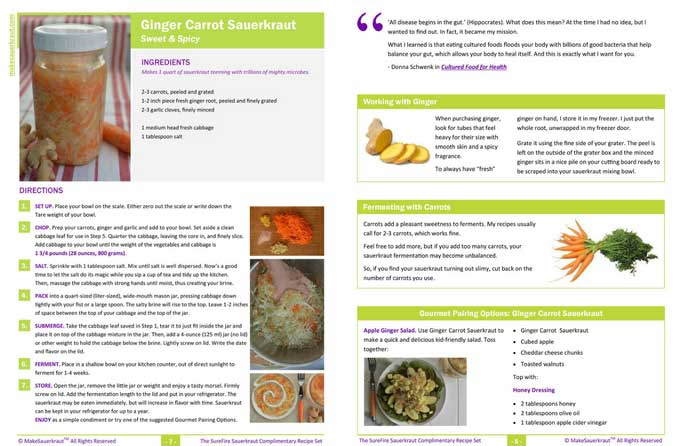
FREE PDF Download
Use the button below to get your own PDF copy of the Ginger Carrot Sauerkraut Recipe.
All my sauerkraut recipes include a downloadable PDF in the same style as the recipes in my eBook: The SureFire Sauerkraut Recipe Collection.
Click to Download the above PDF for My Ginger Carrot Sauerkraut Recipe with its useful set of tips and Gourmet Pairing Options on the backside. NO OPTI-IN required.
Want More Delicious Sauerkraut Recipes? Click Below to Check Out My eBook: The SureFire Sauerkraut Recipe Collection

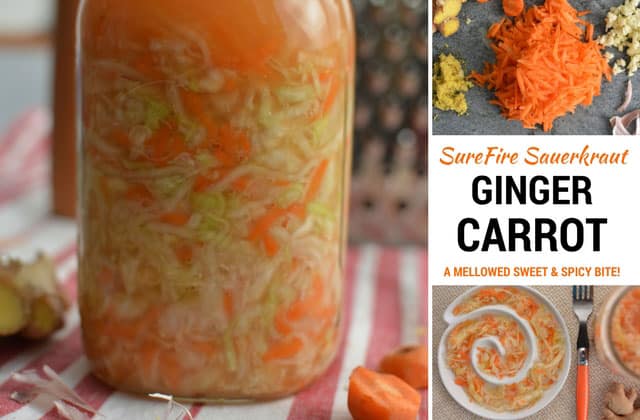
Last update on 2024-07-26 / Affiliate links / Images from Amazon Product Advertising API

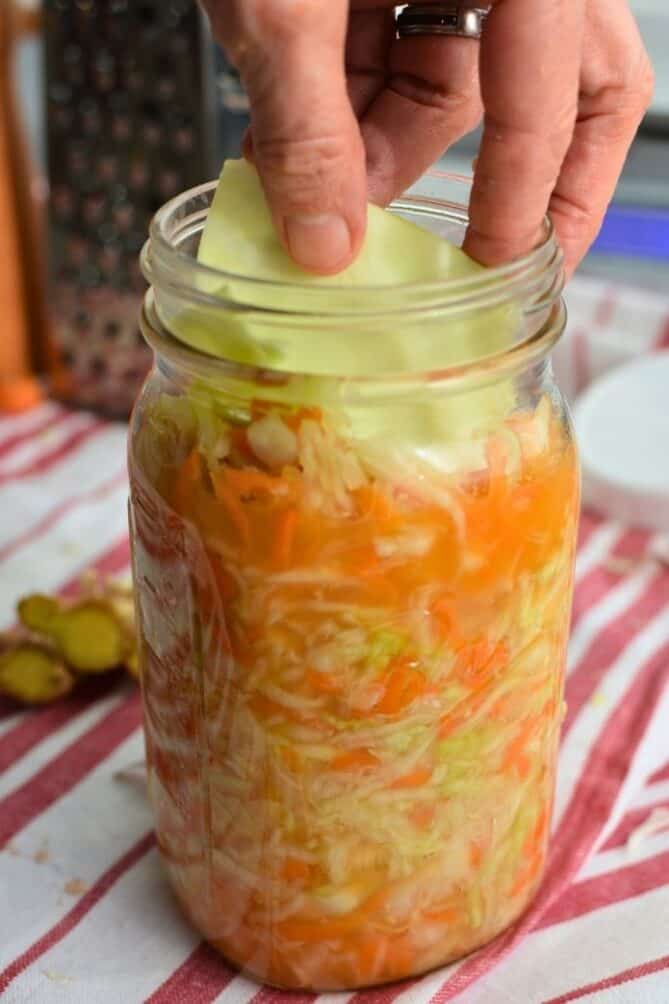

 This post may contain affiliate links which won’t change your price but will share some commission.
This post may contain affiliate links which won’t change your price but will share some commission.